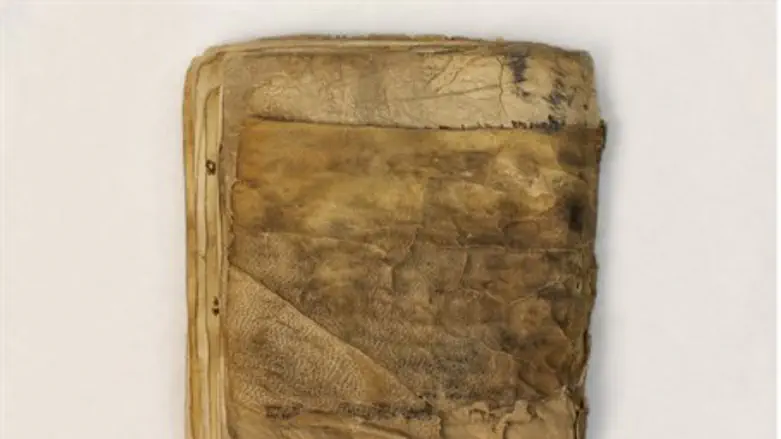
A siddur, or Jewish prayerbook, dated to about 840 CE, is the third major find this year connecting the modern day Jewish world with the Jews' ancient historical and religious past. It was preceded by a stunning golden medallion found near the Temple Mount and the oldest known Torah scroll, found in Italy.
The Green Collection, one of the world’s largest collections of rare biblical texts and artifacts, has announced that it has identified what is likely the oldest Jewish prayer book (siddur in Hebrew) ever found, dated by both scholars and Carbon-14 tests to circa 840 C.E. The artifact may well be the earliest connection today’s practicing Jews have to the roots of their modern-day rabbinic liturgy.
The complete parchment codex is in its original binding, containing Hebrew script so archaic that it incorporates Babylonian vowel pointing (akin to Old or Middle English for the English language). That vowel pointing has led researchers to place the prayer book in the times of the Geonim (Babylonian, Talmudic leaders during the Middle Ages).
“This find is historical evidence supporting the very fulcrum of Jewish religious life,” said Dr. Jerry Pattengale, executive director of the Green Scholars Initiative, the research arm of The Green Collection. “This Hebrew prayer book helps fill the gap between the Dead Sea Scrolls and other discoveries of Jewish texts from the ninth and 10th centuries.”
The announcement by The Green Collection comes just months after scholars in Italy identified the oldest-known Torah scroll from the 12th and 13th centuries; this Jewish prayer book dates some 300-400 years earlier.
Research on the prayer book will be released in late 2014 or early 2015 by the Green Scholars Initiative in its upcoming Brill Series on Early Jewish Texts and Manuscripts edited by Pattengale and Dr. Emanuel Tov. The series will feature in-depth examination of some of the world’s oldest and most rare biblical texts, including portions from the books of Genesis, Exodus, Leviticus, Numbers, Nehemiah, Jeremiah, Jonah, Ezekiel, Micah, Daniel and the Psalms.
Dr. Stephen Pfann, a senior scholar with the Green Scholars Initiative and president of The University of the Holy Land in Jerusalem, along with his students participating in the research project, made the initial discovery among other items from The Green Collection.
To date, Pfann’s team has been able to identify six distinct sections in the siddur, including: 100 blessings/morning prayers (the earliest form of what is in today’s Jewish prayer books, even older than those of Rabbis Amram Gaon and Saadia Gaon); the Passover Haggadah; a poem on the Song of Songs in conjunction with Sukkot; a poem on the End Times (apocalyptic text of an international battle); a poetic form of the book of Zerubbabel; and a unique section entitled, “Salvation in Zion”
“The public will have the opportunity to witness the prayer book, along with the findings from The Green Scholars Initiative’s initial round of research, at a new museum, expected to open in Washington in early spring 2017,” said Steve Green, president of the national arts and crafts retailer Hobby Lobby. Green oversees support for the collection on behalf of his family.
“The research conducted by Green scholars the world over will bring to light the contents of valuable early Jewish texts—from Dead Sea Scrolls and Cairo Genizah leaves to rare manuscripts still being identified,” said Pattengale.
12th century Torah scroll
In late May, it was announced that the world's oldest complete Torah scroll has been found in a university archive in Bologna. An Italian professor said the text could be from the 12th century.
The precious parchment scroll had been classified by the university library as being from the 17th century and was named simply "Scroll Number Two".
However, Hebrew Studies professor Mauro Perani told the AFP news agency he noticed that the text did not conform to key changes in Torah writing brought about in the 12th century.
"I immediately thought it was much older," he said, adding that it contained letters and signs that were banned by Jewish scholar and philosopher Moses Maimonides in the 12th century.
The Torah was among around 30 Jewish manuscripts in the university library that Perani began to catalogue in February of this year.
Golden Torah medallion
In summer excavations at the foot of the Temple Mount, Hebrew University of Jerusalem archaeologist Dr. Eilat Mazar made a stunning discovery: two bundles of a 1,400-year-old treasure containing thirty-six gold coins, gold and silver jewelry, and a gold medallion with the menorah (Temple candelabrum) symbol etched into it. Also etched into the 10-cm medallion are a shofar (ram’s horn) and the image of a Torah scroll.
The medallion may be the oldest Torah ornament ever found in archaeological digs.
Together, the three finds provide tangible evidence of the continuity of Jewish religious practice following the destruction of the Second Temple and the continued striving for the actual rebuilding of a Jewish Jerusalem.